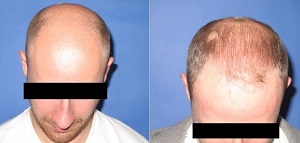I have covered the link between fat cells and hair cells a number of times on this blog in the past. In this post, I discuss Stromal Vascular Fraction (SVF) enhanced adipose transplantation for hair growth.
The regenerative action of SVF is largely attributed to its paracrine effect on neighboring cells via the secretion of various growth factors and cytokines. This includes adipose tissue-derived stromal cells (ASCs).
Update: December 16, 2022 — A new study concludes that autologous stromal vascular fraction injection treatment of androgenic alopecia is effective.
Update: August 2021 — A South Korea study covered nine AGA patients who received one single transplantation of autologous SVF via injection. The results showed increased hair density and “keratin scores” after 6 months.
Update: December 2020 — A Turkish study on 20 patients concluded that SVF is an effective and safe treatment for AGA patients. The average patient saw an almost 25% increase in both hair count and hair thickness. Interestingly, the researchers also included dermapen wounding alongside the SVF treatment in order to boost regaional blood supply. Make sure to read my post on microneedling for hair growth.
Fat Cells and Scalp Hair Growth
- In 2014, I discussed a newly published paper by Dr. Fiona Watt and various others that found a positive correlation between hair growth, adipocytes (fat cells) and epidermal Wnt/β-catenin signaling. One of their findings (albeit on a small sample size) was that “regions of hair loss were correlated with reduced adipocyte layer thickness in the samples we examined“.
- Thereafter, in March 2015, I wrote about Dr. Valerie Horsley’s work related to fat cells and scalp hair.
- In April 2015, I wrote a post on adipose-derived stem cells (ADSCs) and hair growth.
- Also in April 2015, I wrote about Advanced Adipose-Derived Stem Cell Protein Extract (AAPE) and hair growth.
- In July 2015, I wrote a post on an upcoming company named Kerastem that was working on using autologous fat graft enriched with adipose-derived regenerative cells (ADRCs) in the treatment of early male pattern hair loss. Kerastem has become much more renowned since then, and has been conducting clinical trials under the acronym STYLE. These trials are supposed to be complete in September 2017, and the renowned Dr. Ken Washenik is actively involved. I have discussed Kerastem in several other post since 2015.
- In my February 2017 brief items of interest post, I discussed the STRAAND clinical trials that will be completed in June 2018. These trials focus to on something called stromal vascular fraction (SVF), which is a type of adipose tissue, and platelet-rich plasma (PRP).
There are some significant differences between some of the above subject matters, but in the end, they all involve adipose tissue and hair growth.
A number of doctors around the world are now offering procedures where they inject adipose tissue into your scalp, often with the addition of growth factors and various stem cells. In most cases, these procedures are insufficiently tested and largely unproven.
I am skeptical about the potential of these treatments beyond making existing hair stronger and perhaps reversing very recent follicle miniaturization (in an absolute best case scenario). However, I remain open minded based on the assorted wide range of work from around the world related to fat cells and hair growth that is outlined in the earlier listed bullet point past posts of mine.
Stromal Vascular Fraction (SVF) Enhanced Adipose Transplantation
As several commentators have pointed out, this week fat cells and hair were in the news yet again. This time, the excitement was limited to UK newspapers due to some work in which locally based Dr. Edward Ball was involved (note that the actual study is here and the principal author is Dr. David Perez-Meza).
Update: It seems like this whole study is related to Kerastem’s Celution System technology (and Puregraft’s fat purification technology). See Kerastem CEO update here. Strange that both the UK newspaper stories (see bottom of this post) that covered this development do not even mention Kerastem.
Before and after image below from the Maitland Clinic per the two UK newspaper links further below:

Basically, they conducted a small study in which they removed fat from six people’s stomachs, added stem cells to the fat, and then moved the resulting concoction to the same people’s scalps. They supposedly got great results. The procedure is described as “Stromal Vascular Fraction (SVF) Enhanced Adipose Transplantation”. Dr. Craig Ziering was also involved, and I have covered him on this blog several times in the past. I can’t think of many superficial things that I would love more in life then less stomach fat and more scalp hair:
— Express article on moving fat cells from stomach to scalp.
— The Sun article on moving fat cells from beer belly to scalp.
Note that there was another small-scale nine patient study done on SVF enhanced adipose transplantation in 2016 with a favorable conclusion. Two of the authors in that one were Dr. Ken Washenik and Dr. Eric Daniels (the latter also co-authored this latest study).